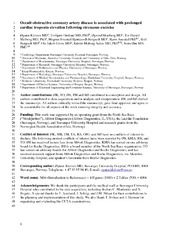Occult obstructive coronary artery disease is associated with prolonged cardiac troponin elevation following strenuous exercise
Kleiven, Øyunn; Omland, Torbjørn; Skadberg, Øyvind; Melberg, Tor Harald; Bjørkavoll-Bergseth, Magnus; Auestad, Bjørn Henrik; Bergseth, Rolf; Greve, Ole Jacob; Aakre, Kristin Moberg; Ørn, Stein
Peer reviewed, Journal article
Accepted version
Permanent lenke
https://hdl.handle.net/1956/22286Utgivelsesdato
2019Metadata
Vis full innførselSamlinger
Originalversjon
https://doi.org/10.1177/2047487319852808Sammendrag
Background: Sudden cardiac death among middle-aged recreational athletes is predominantly due to myocardial ischaemia. This study examined whether measuring cardiac troponin I and T (cTnI and cTnT) after strenuous exercise could identify occult obstructive coronary artery disease. Design: Prospective observational study. Methods: Subjects were recruited from 1002 asymptomatic recreational cyclists completing a 91-km mountain bike race (North Sea Race Endurance Exercise Study). No subject had known cardiovascular disease or took cardiovascular medication. Blood samples were collected within 24 h before and 3 h and 24 h after the race. Coronary computed tomography angiography was performed in 80 participants with the highest post-exercise cTnI and in 40 reference subjects with moderately elevated cTnI values. Results: Study subjects (N = 120) were 45 (36–52) years old and 74% were male. There were similar demographics in the High-cTnI group and the Reference group. The cTn concentrations were highest at 3 h post-race: cTnI, 224 (125–304) ng/L; cTnT, 89 (55–124) ng/L. Nine subjects had obstructive coronary artery disease on coronary computed tomography angiography, eight of whom were High-cTnI responders. Two subjects had myocardial bridging, both High-cTnI responders. Troponin concentrations at 24 h post-race were higher in subjects with obstructive coronary artery disease than in the rest of the cohort (n = 109): cTnI, 151 (72–233) ng/L vs. 24 (19–82) ng/L, p = 0.005; cTnT, 39 (25–55) ng/L vs. 20 (14–31) ng/L, p = 0.002. The areas under the receiver operating characteristic curves for predicting obstructive coronary artery disease were 0.79, p = 0.005 (cTnI) and 0.82, p = 0.002 (cTnT). Conclusion: In subjects with occult obstructive coronary artery disease there was a prolonged elevation of cTn following strenuous exercise.
